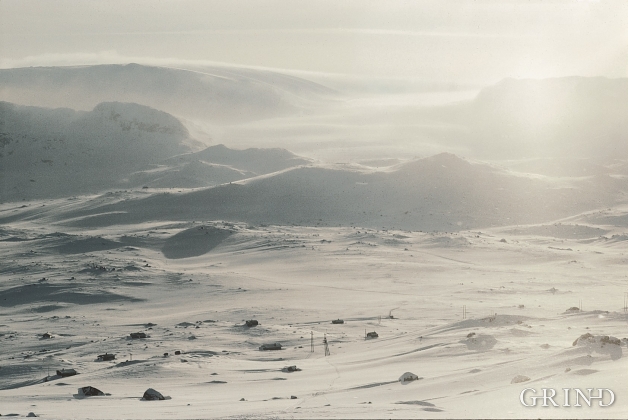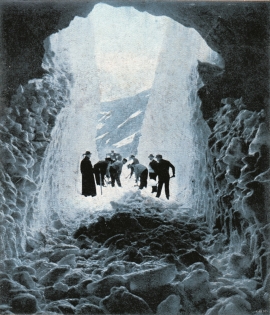Published: 13.08.2015 | Author: Arve Tvede
Finse Mountain: From Jomfrunuten toward Kongsnuten and Jøkulen. The Bergen Railway below in the foreground. (Svein Nord)
Opponents of the Bergen Railway used the snow argument for all it was worth. During the debate in Parliament before the decision about the route was reached in 1894, fears of snowfalls of over 20 metres were presented.
But the railway was built - and the route was chosen largely on the basis of snow measurements. The first systematic measurements were made during the planning of the railway in the 1880s. Even before the work began, it was clear that snowfall would be the biggest challenge, both under construction and not least for the operation of the trains. The snow depth was measured at permanent locations along all of the possible routes, over many winters. The work was commissioned by engineers of the National Railway Association and carried out by local mountain farmers. Several stone shelters were built in order to facilitate the work. Later, snow measurements were also made in connection with the planning of snow-screens along the railway route. We can study some of the results today at the Rallarmuseet (Railway Museum) at Finse.
Eventually, after the rivers from Hardangervidda were built out for hydropower, some of the power stations also carried out snow measurements. The measurements were made in the reservoir area before the melting season started, usually just after Easter. Their objective was to evaluate how much meltwater would reach the power plants via seepage into their reservoirs later in the spring and summer. This influenced their operating plans. In the intense competition between the power stations, such snow data could be an important business secret.
The average snow depth on flat ground decreased from over 2 metres to just 1 metre from west to east on the plateau. Even further east, in Buskerud county, the normal snow depth has decreased to less than 1 metre. The measurements show large variations from winter to winter, dependent on the dominant meteorological conditions through the snow season. In typical "westerly-wind" winters the amount of snow is always most on the western plateau. In winter with more south-easterly and easterly wind directions, the difference can be small. Ulvik holds the national record for the greatest measured snow depth on flat ground: 585 centimetres at Grjotrusti, the 3rd of April, 1918.
People at work in the snow. The Bergen Railway between Myrdal and Finse gets shovelled out in the winter of 1908. (Anders Beer Wilse)
From the Parlimentary Proposition nr. 1 in 1890: Table of snow depths after snow measurements along the planned railway route in the 1880s. Snow measurements were carried out by local mountain farmers over several years. The farmers often stayed overnight in tents, but several shelters were also built in the mountains to ease the heavy work.
- Bach T.; Gjerdåker J. 1992. Rallarvegen. Kulturhistorisk vegvisar for høgfjellsvegen langs Bergensbana. Cappelen.
- Bygdebok for Ulvik. Bd. I. 1987.





